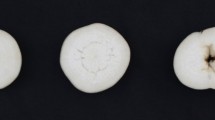Summary
Germinated seeds of the annual Westerwolths ryegrass were treated with colchicine-solutions of 0.05 to 0.4% at a temperature of 29°C in order to obtain autotetraploids. The best results were obtained after treatment for 2 hours with 0.1 and 0.2% solutions or 4 hours with 0.05%. By these procedures about 8% of the treated seeds produced mixoploid or tetraploid mature plants. A preliminary progeny test was performed with seed of outstanding C1-plants.
In spaced plants and in drilled rows the dry matter production of these C2-families was on average equally as high as that of the most productive original diploid variety. The proportion of leaves was higher in both the first and in the second cut, while drought resistance was considerably better. The tetraploids came later into ear, tillering ability was smaller and mildew attack was slightly heavier. In samples from drilled and from space-planted rows seed production per inflorescence was found to be higher in the tetraploids than in the diploids. The seed of the tetraploids was larger.
From the data available it is concluded that chromosome doubling offers favourable possibilities for the improvement of Westerwolths ryegrass. Some suggestions for a breeding programme are given.
Samenvatting
Ter verkrijging van autotetraploiden werden gekiemde zaden van het eenjarige Westerwolds raaigras gedurende 1/2 tot 4 uur behandeld met colchicine-oplossingen van 0.05% tot 0.4% bij 29°C. Met behandelingen van 2 uur met 0.1% en 0.2% en 4 uur met 0.05% werden de beste resultaten verkregen. Hierbij gaven gemiddeld 8% van de behandelde zaden volwassen planten die geheel of gedeeltelijk tetraploid waren.
Met zaad van uitblinkende C1-planten werd een oriënterende nakomelingschapstoetsing uitgevoerd. De productie aan droge stof was zowel bij rijen afzonderlijke planten als bij gezaaide rijtjes gemiddeld even hoog als die van het meest productieve diploide uitgangsras; het bladaandeel was zowel in de eerste als in de tweede en derde snede hoger, de droogteresistentie was aanmerkelijk groter. De aarvorming van de tetraploiden was later, de uitstoeling geringer en de aantasting door meeldauw iets sterker. Het zaad der tetraploiden is groter, de zaadopbrengst per halm was in deze oriënterende proeven hoger.
Uit de gegevens wordt geconcludeerd dat chromosomenverdubbeling voor de veredeling gunstige perspectieven biedt. Enige wenken voor de veredeling van tetraploid Westerwolds raaigras zijn aangegeven.
Similar content being viewed by others
Literature
Haan, H. de, The origin of Westerwolths ryegrass. Euphytica 4 (1955): 206–210.
Hill, Helen, D. and Meyers, W. M., Isolation of diploid and tetraploid clones from mixoploid plants. Journal of Heredity 35 (1944): 359–361.
Myers, W. M., Colchicine induced tetraploidy in perennial ryegrass. Journal of Heredity 30 (1939): 499–504.
Speckmann, G. J., A rapid laboratory method for cytological control in polyploidy breeding. Euphytica 4 (1955): 163–166.
Wit, F. and Speckmann, G. J., Breeding of tetraploid ryegrass. European Grassland Conference, Paris 21–24 Juni 1954 (Mimeographed).
Wit, F., De perspectieven van chromosomen verdubbeling voor de veredeling van raaigrassen en rode klaver. Landbouwkundig Tijdschrift 66 (1954): 533–536.
Author information
Authors and Affiliations
Rights and permissions
About this article
Cite this article
Wit, F., Speckmann, G.J. Tetraploid Westerwolths ryegrass. Euphytica 4, 245–253 (1955). https://doi.org/10.1007/BF00037294
Received:
Issue Date:
DOI: https://doi.org/10.1007/BF00037294




